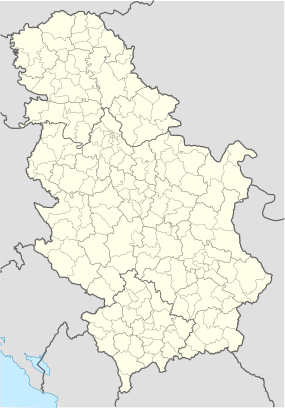Vinča-Belo Brdo
| Винча-Бело брдо | |

The site of Vinča-Belo Brdo
|
|
| Location | Vinča, Belgrade, Serbia |
|---|---|
| Coordinates | 44°45′43″N 20°37′23″E / 44.76194°N 20.62306°ECoordinates: 44°45′43″N 20°37′23″E / 44.76194°N 20.62306°E |
| Type | Settlement |
| Area | 10 ha (25 acres) |
| History | |
| Founded | Approximately 5700 BCE |
| Periods | Neolithic, Copper Age, Bronze Age, Iron Age, Medieval |
| Cultures | Starčevo, Vinča, Bodrogkeresztúr, Baden, Kostolac, Vatin, Celtic |
Vinča-Belo Brdo (Serbian: Винча-Бело брдо) is an archaeological site in Vinča, a suburb of Belgrade, Serbia. The tell of Belo Brdo ('White Hill') is almost entirely made up of the remains of human settlement, and was occupied several times from the Early Neolithic (c. 5700 BCE) through to the Medieval period. The most substantial archaeological deposits are from the Neolithic-Eneolithic Vinča culture, of which Vinča-Belo Brdo is the type site.
Vinča is situated on the right bank of the Danube, 14 km downstream from Belgrade, on a high loess terrace. This location was attractive to its Neolithic settlers: the Danube on one side provided water and fishing while on the other the valley of the river Bolecica connected it to a hinterland rich in minerals, ores, hunting grounds and fertile agricultural soils. Belo Brdo is one of the largest tell sites in the Balkans, covering 10 hectares of land with 9 metres of cultural deposits and a total height of 10.5 metres.
The first archaeological excavations at Vinča were carried out by prominent Serbian archaeologist Miloje Vasić starting in 1908. These were interrupted by the outbreak of World War I and, apart from a brief season in 1924, Vasić was unable to obtain the necessary funding to continue working on the site from the impoverished postwar Yugoslav government. However, with the financial backing of British businessman and archaeologist Sir Charles Hyde, Vasić was able to resume excavations, on a much larger scale, between 1929 and 1931. These piqued the interest of the British press and the site was subsequently visited by several prominent intellectuals of the time, including Hyde, John Myres, Veselin Čajkanović, W. A. Hurtley and Bogdan Popović. Finds from these excavations are now in several UK museums including the Ashmolean Museum and the British Museum.
...
Wikipedia

